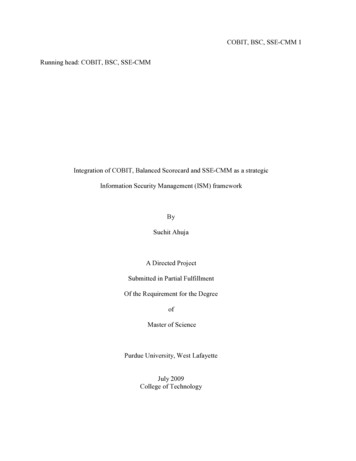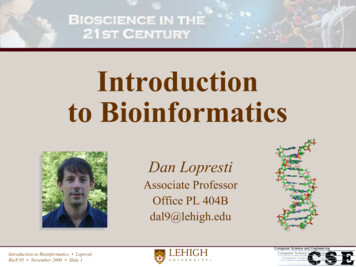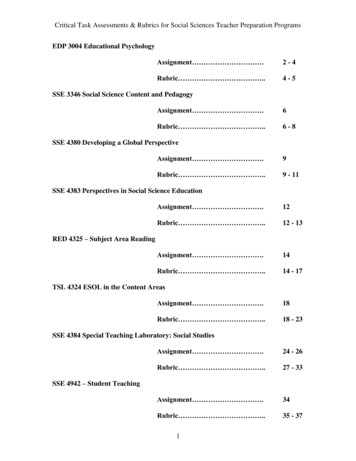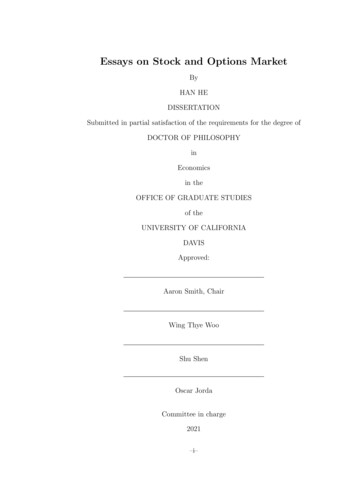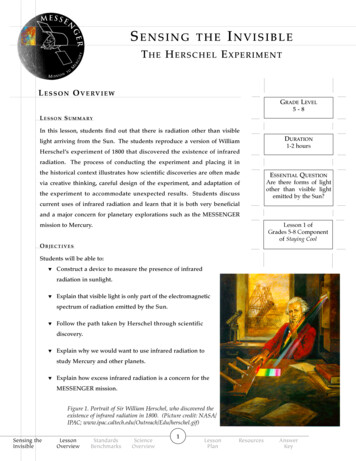
Transcription
MESSENGESensingRtheInvisibleMercuryT h e H e r s c h el E x p e r i m e n tMissiontoL e s s o n O v e rv i e wGrade Level5-8L e s s o n S u m m a ryIn this lesson, students find out that there is radiation other than visiblelight arriving from the Sun. The students reproduce a version of WilliamHerschel’s experiment of 1800 that discovered the existence of infraredDuration1-2 hoursradiation. The process of conducting the experiment and placing it inthe historical context illustrates how scientific discoveries are often madevia creative thinking, careful design of the experiment, and adaptation ofthe experiment to accommodate unexpected results. Students discusscurrent uses of infrared radiation and learn that it is both very beneficialEssential QuestionAre there forms of lightother than visible lightemitted by the Sun?and a major concern for planetary explorations such as the MESSENGERLesson 1 ofGrades 5-8 Componentof Staying Coolmission to Mercury.ObjectivesStudents will be able to: Construct a device to measure the presence of infraredradiation in sunlight. Explain that visible light is only part of the electromagneticspectrum of radiation emitted by the Sun. Follow the path taken by Herschel through scientificdiscovery. Explain why we would want to use infrared radiation tostudy Mercury and other planets. Explain how excess infrared radiation is a concern for theMESSENGER mission.Figure 1. Portrait of Sir William Herschel, who discovered theexistence of infrared radiation in 1800. (Picture credit: NASA/IPAC; sing ceOverview LessonPlanResourcesAnswerKey
Version 2.4, June 2010This lesson was developed by the National Center forEarth and Space Science Education (http://ncesse.org).Concepts Visible light consists of different colors. Sunlight consists of invisible forms of light in addition to visible light, oneof which is infrared light. Scientific discoveries are sometimes made by chance, as a by-product ofanother investigation.MESSENGER M i s s i o n C o n n e c t i o nThe MESSENGER mission to Mercury uses infrared light to study propertiesof the planet, and it is therefore beneficial to the mission. However, too muchinfrared radiation is detrimental to the spacecraft and its instruments, andengineers are faced with this problem when designing the MESSENGERspacecraft and ienceOverview LessonPlanResourcesAnswerKeyNSensing theInvisibleGERDo not look directly at the Sun!This lesson is about the Sun and sunlight, but be sure to remind students frequentlynever to look directly at the Sun! Looking for even a few seconds can cause permanent damage to the eyes, and longer exposure can cause blindness. Note that sunglasses do not provide an adequate safeguard against looking directly at the Sun.MESSE
S ta n d a r d s & B e n c h m a r k sN at i o n a l S c i e n c e E d u c at i o n S ta n d a r d sStandard B3 Transfer of energy The sun is a major source of energy for changes on the earth’s surface. The sun losesenergy by emitting light. A tiny fraction of that light reaches the earth, transferring energyfrom the sun to the earth. The sun’s energy arrives as light with a range of wavelengths,consisting of visible light, infrared, and ultraviolet radiation.Related StandardsStandard G1 Science as a human endeavor Science requires different abilities, depending on such factors as the field of study andtype of inquiry. Science is very much a human endeavor, and the work of science relieson basic human qualities, such as reasoning, insight, energy, skill, and creativity—aswell as on scientific habits of mind, such as intellectual honesty, tolerance of ambiguity,skepticism, and openness to new ideas.Standard G2 Nature of science Scientists formulate and test their explanations of nature using observation, experiments,and theoretical and mathematical models. Although all scientific ideas are tentative andsubject to change and improvement in principle, for most major ideas in science, there ismuch experimental and observational confirmation. Those ideas are not likely to changegreatly in the future. Scientists do and have changed their ideas about nature when theyencounter new experimental evidence that does not match their existing explanations.Standard G3 History of science Many individuals have contributed to the traditions of science. Studying some ofthese individuals provides further understanding of scientific inquiry, science as a iew LessonPlanResourcesAnswerKeyNSensing theInvisibleGERendeavor, the nature of science, and the relationships between science and society.MESSE
A m e r i c a n A s s o c i at i o nfor theA d va n c e m e n tofS c i e n c e , P r o j e c t 2061Benchmark 4F2 Light from the sun is made up of a mixture of many different colors of light,even though to the eye the light looks almost white. Other things that give off or reflect lighthave a different mix of colors.Benchmark 4F5 Human eyes respond to only a narrow range of wavelengths of electromagneticradiation—visible light. Differences of wavelength within that range are perceived asdifferences in color.Benchmark 12C3 Read analog and digital meters on instruments used to make directmeasurements of length, volume, weight, elapsed time, rates, and temperature, and chooseappropriate units for reporting various magnitudes.Related BenchmarksBenchmark 1B1 Scientists differ greatly in what phenomena they study and how they goabout their work. Although there is no fixed set of steps that all scientists follow, scientificinvestigations usually involve the collection of relevant evidence, the use of logical reasoning,and the application of imagination in devising hypotheses and explanations to make sense ofthe collected evidence.Benchmark 1B4 New ideas in science sometimes spring from unexpected findings, and ew LessonPlanResourcesAnswerKeyNSensing theInvisibleGERusually lead to new investigations.MESSE
S c i e n c e O v e rv i e wSunlight is the source of life-sustaining energy onUniverse. Magnetic objects behave in a similarEarth. Its effects range from allowing temperaturesfashion: every magnetic object creates a magneticon our planet to remain hospitable for life tofield around it, and their collective magnetic fieldproviding energy for photosynthesis. In addition topermeates the Universe.light that can be seen with the human eye—visiblelight—there are other forms of energy emitted byMost things in the Universe tend to move around,the Sun. In this lesson, we discuss one of theseand electric charges are rarely an exception. If theother forms—infrared radiation.velocity of an electric charge changes (that is, itaccelerates or decelerates), it creates a disturbanceThe Electromagnetic Spectrumin the electric and magnetic fields permeating theWeather forecasters often show temperature mapsUniverse.of the United States based on the temperatureUniverse as waves in the "fabric" of the electricmeasurements in different parts of the countryand magnetic fields. The waves also carry energythat day. The maps are created by assigning eachfrom the disturbance with them, in a similartemperature a color, and then filling the mapway that the energy of the wind striking a flag iswith colors corresponding to the temperaturescarried across the fabric by the waving of the flag.measured at each location. A map created thisThe waves carrying the energy of the disturbanceway shows the temperature field of the Unitedacross the Universe are characterized by theirStates on that particular day. The temperaturewavelength, which measures the distance betweenfield covering the United States, in this sense, is atwo consecutive wave crests.These disturbances move across thedescription of the temperatures at every locationacross the country.A familiar example of this kind of wave is visiblelight. Different colors of visible light have slightlyIn a similar fashion, the Universe can be thoughtdifferent wavelengths, and there are waves whichof as being permeated by an electric field. Allhave much higher and shorter wavelengths than theelectrically charged particles (such as electrons)light that humans can see. Together, the waves ofhave a region of space around them where theyall different wavelengths are called electromagneticinfluence the behavior of other charged particlesradiation, and the whole array of different kindswandering there. This region can be describedof light, arranged according to their wavelength, isas an electric field around the particle. Just ascalled the electromagnetic spectrum (See Figure 2).temperatures in different parts of the countryElectromagnetic radiation travels at the speed ofcreate the temperature field of the United States,light (300,000 km/s or 186,000 miles/s in a vacuumthe electric charges in the Universe can be thoughtsuch as rview LessonPlanResourcesAnswerKeyNSensing theInvisibleGERof as creating an electric field permeating the wholeMESSE
Figure 2. The electromagnetic spectrum. In the picture, different parts of the spectrum are shown as one continuous wave.In reality, a given electromagnetic wave has one particular wavelength. The continuous wave in picture above is used tobetter illustrate the difference between wavelengths from one part of the spectrum to another.The complete electromagnetic spectrum includes: light from the submerged part of the stick changesRadio waves (including microwaves): Used fordirection as it reaches the surface, and our eyestransmitting radio and television.perceive the refracted light as the illusion of a bentstick.Infrared: Seen by many animals (not humans),also used in night vision goggles.The same effect happens when visible light passesVisible light: The portion of the spectrum thatthrough a prism. In this case the different colorshumans can see.of light are bent (refracted) onto different paths Ultraviolet: Causes sunburns.according to their wavelength. A beam of light can X-rays: Used in hospitals to make internalconsist of just one color, so that only one color oflight enters the prism and the same color exits,images of the human body.Gamma rays: Used in radiation treatments ofof a mixture of colors, so that the mixture of colorscancer.enters the prism and each color exits the prismbent onto a path of its own. Shorter wavelengthsLight travels at different speeds through different(blue and violet) are refracted, or bent, more thanmaterials. When light moves from one substance tolonger wavelengths (red), resulting in the familiaranother (for example, when a beam of light passesrainbow pattern of colors. Radiation that is notthrough air and into water, or vice versa), it changesvisible also is refracted according to wavelength.its speed, and therefore its direction if it enters theBeyond the red end of visible light is the infrared,substance at an angle. This effect (called refraction)and beyond the blue is the ultraviolet part of theis noticeable if a stick is placed halfway under water;Sensing ceOverviewelectromagnetic spectrum. LessonPlanResourcesAnswerKeyGER bent onto a new path; or, a beam of light can consistN MESSE
Sunlight, as it emerges from the Sun, consists ofsee with our eyes are visible to us because theyall types of electromagnetic radiation. The Earth’sreflect the light from a hot source—the Sun duringatmosphere reflects away or absorbs much of thethe day, a light bulb at night—and they are not hotelectromagnetic spectrum, so that only part of theenough to emit visible light themselves. Humans,radiation reaches the surface. Most radio waveswith body temperatures around 37 C (99 F), emitcome through the atmosphere unimpeded, visibleinfrared radiation but no visible light—we seelight passes through without much difficulty, whileeach other because we reflect the light from a lightonly some infrared radiation, very little of thesource. If we could see infrared light, we wouldultraviolet rays, and none of the X-rays and gammabe able to see each other even in the middle ofrays reach the surface. This is very fortunate forthe night. Some animals, such as rattlesnakes, canlife on Earth because some kinds of radiationdetect infrared light. This allows the snake to find(such as ultraviolet light, X-rays, and gamma rays)warm-blooded animals, such as small rodents, bycan break apart molecules in living things. Mostdetecting the infrared radiation that they emit.forms of life could not survive unprotected on theEarth's surface if the atmosphere did not almostInfrared radiation is used in many moderncompletely shield us from these harmful forms ofapplications. The most familiar instance of everydayradiation.use of infrared radiation may be television remotecontrols.Other examples include security andInfrared Radiationsurveillance cameras, and instruments used toInfrared radiation comes from warm objects—theobserve the insides of a human body withoutwarmer the object, the more infrared radiation ithaving to do surgery.emits. If the temperature of the object becomescameras to locate people and animals hiddenvery high, it will emit visible light in addition toby smoke in burning buildings and to find hotinfrared radiation. For example, the filament inspots in forest fires. Engineers use infrared-basedan ordinary light bulb glows with both kinds ofscanners to find heat leaks in buildings and to testradiation when its temperature rises to more thanfor problems in mechanical and electrical systems.2500º C (4500 F). One way to think about this isInfrared satellites are used in investigating globalto say that infrared radiation comes from warmclimate properties, weather phenomena, andobjects while infrared as well as visible light comesvegetation patterns, and even to discover ancientfrom hot objects. Even hotter objects (for example,roads in archaeological studies. Astronomers usestars) will emit infrared, visible, as well as eveninfrared imaging to study a variety of objects, suchmore energetic forms of light such as ultravioletas newly formed stars and the most distant galaxiesor X-rays. Remember that most of the objects wein the Universe. Infrared radiation is very usefulStandardsBenchmarksScienceOverview ing theInvisibleFirefighters use infraredMESSE
for studying planets in the Solar System. Planetscontribution to science in the year 1800. In hisreflect away much of the sunlight they receive, butastronomical work, Herschel noticed that when hethey absorb part of it. The light heats up the surfaceused filters of different colors to observe sunlight,of the planets to warm (but not hot) temperatures,the filters seemed to let through different amountsand the surfaces emit infrared light (as all warmof heat. He thought that the colors themselvesobjects do). Using this emitted infrared radiationmight be of varying temperatures and devised anto make observations of the planets providesexperiment to investigate his hypothesis.invaluable clues to their properties which may bedifficult to determine otherwise. Since much ofHerschel directed sunlight through a glass prismthe infrared radiation arriving from astronomicalto create a spectrum and then measured theobjects is blocked by Earth’s atmosphere, infraredtemperature of a thermometer illuminated by eachtelescopes have been launched to make theircolor in turn. He noticed that the temperatureobservations from space.increased from the blue to the red end of the visiblespectrum.After noticing this pattern, HerschelConsidering the many ways in which infrareddecided to measure the temperature just beyondradiation is important in our lives, it is remarkablethe red portion of the spectrum in a region thatto realize that its existence was not discovereddid not appear to have any sunlight falling on it.until a little over two centuries ago by Sir WilliamTo his surprise, he found that this region had theHerschel.highest temperature of all. He realized that theremust be another type of light beyond the red, lightSir Frederick William Herschelthat we cannot see. He probably could not haveSir Frederick William Herschel (1738-1822) wasbeen expected to discover ultraviolet light beyondborn in Hanover, Germany, and became wellthe blue end of his spectrum, as most (but notknown both as a musician and as an astronomer.all) materials that transmit visible light are veryHe moved to England in 1757 and, with his sistereffective in absorbing ultraviolet light, and thusCaroline, constructed telescopes to survey thehis prism would not have provided the ultravioletnight sky. Their work resulted in several catalogsportion of the Sun's spectrum.of double stars and nebulae. Herschel is famousfor his discovery of the planet Uranus in 1781, theHerschel performed additional experiments on thefirst new planet found since ancient times.rays he had discovered beyond the red portion ofthe spectrum. He found that they were reflected,refracted, absorbed, and transmitted in a mannerSir William Herschel made another importantsimilar to visible light. He called this new kind ofLessonOverviewStandardsBenchmarksScienceOverview LessonPlanResourcesAnswerKeyNSensing theInvisibleGERThe Herschel ExperimentMESSE
light “calorific rays,” derived from the Latin wordthat he was measuring the intensity of sunlightfor “heat.” Today, this form of light is known asat different wavelengths rather than any inherentinfrared radiation.The word "infra" is derivedproperty of different colors of visible light, butfrom the Latin word for “below”—it describeswhen this distinction is made clear, the hypothesiswhere you find the infrared radiation on thestill remains valid.electromagnetic spectrum when compared withvisible light.Herschel did not stop there, and this showsan important aspect of the scientific process.Herschel’s experiment is important because it wasSometimes experiments designed to investigate athe first time someone demonstrated that therespecific question can produce unexpected resultsare types of light we cannot see with our eyes.and lead to even more important discoveries.As we now know, there are many other types ofWhen Herschel noticed that the temperaturesradiation that we cannot see, and the visible colorsincreased toward the red end of the visibleare only a small part of the entire range of thespectrum, he continued the experiment to measureelectromagnetic spectrum.the temperatures beyond the visible part of thespectrum, and discovered the existence of infraredThe Herschel Experiment as an Example ofradiation.Scientific Discoveryexperiment to determine whether there wasHerschel’s experiment is a good demonstrationradiation beyond the visible part of the spectrum,of how scientific progress takes place. Herschelbut once the experiment hinted that this mightstarted out with a question based on his researchbe the case, he was able to come up with a new,and experience: he noticed that different colormodified question and augment his experimentfilters seemed to pass different amounts of heat andto test the new hypothesis. This versatility andwanted to find out if this was really the case. Heability to modify one’s perspective, questions, anddevised a hypothesis based on this observation—experiment in the middle of the process, while stillthat the colors themselves could be of varyingmaintaining the integrity of the experiment, aretemperatures. He designed an experiment to testimportant characteristics of a good scientist.He had not originally designed thethe hypothesis—measuring the temperatures ofInfrared Radiation and the MESSENGER Missionnoticing that the temperatures of the differentInfrared radiation is of great importance in thecolors appeared to indeed be different, he wasdesign of the MESSENGER spacecraft and inable to confirm his hypothesis. It is now knownthe operation of its scientific ceOverview LessonPlanResourcesAnswerKeyNSensing theInvisibleGERthe different parts of the visible spectrum. AfterMESSE
One of the instruments on MESSENGER, theThis poses a great engineering challenge to theMercury Atmospheric and Surface Compositionmission design team: How can the spacecraftSpectrometer (MASCS), includes a visible-infraredand its sensitive instruments be protected againstspectrometer, which measures the amount of energyextremely high temperatures while remaining inat different wavelengths in the visible and infraredMercury orbit and exposed to Mercury itself, asparts of the electromagnetic spectrum. Just asrequired to complete its mission? To protect againstrocks and minerals have specific colors in visibledirect sunlight, the spacecraft will have a sunshadelight (e.g., turquoise is blue), they have uniquethat is at all times pointed toward the Sun so that"colors" at infrared wavelengths, providing anthe instruments are always shaded. The spacecraft’senhanced opportunity for MESSENGER to learnorbit around Mercury has been designed so that itswhat Mercury's surface is made of. This will helpclosest approach to the planet is away from theus understand the geologic history of Mercury, asmost sun-baked region of the surface and so that itwell as provide clues to solving one of the biggestflies quickly over the sunlit areas. This is achievedmysteries Mercury poses—why is the planet soby an orbit where the periapsis (the closest pointdense?to the surface of Mercury and also the part of theorbit where the spacecraft’s speed is at its highest)Although it is useful to the scientific goals of theis at a high latitude and the apoapsis (the farthestmission, infrared radiation is also a great concernpoint of the orbit and also the part of the orbitfor MESSENGER. The amount of infrared radiationwhere the spacecraft’s speed is at its lowest) is far(as well as visible light) that the spacecraft receivesaway from the surface of Mercury. In this manner,from the Sun during its orbit around Mercury willinfrared radiation received by the spacecraft canbe up to 11 times higher than it would receivebe kept at safe levels.in Earth orbit. When one considers the fact thatWith these safeguards, MESSENGER’s instrumentsabout half of all solar radiation, the amount ofwill be in a thermal environment that is roughlysunlight MESSENGER will be exposed to cancomparable to room temperature: During thebe more than 20 times as high as what objectsorbital part of the mission, the temperature on theexperience on the surface of Earth. In addition, theinstrument deck of MESSENGER is expected tosurface of Mercury that faces the Sun heats up andvary from a few degrees below 0 C (32 F) to 33 Cemits infrared radiation.(91 w10LessonPlanResourcesAnswerKeyNSensing theInvisibleGEREarth’s atmosphere typically passes through onlyMESSE
Lesson Plan: Herschel’s Infrared ExperimentThe procedure described here is similar to Herschel’s original experiment.The students will create a device in which sunlight will pass through a prismand produce a spectrum of light on the bottom of a cardboard box (see FigureMaterialsS1 in Student Worksheet). Using a series of thermometers (see Figure S3)Per group of three:they will measure temperatures at various locations within, and outside of, the prisms do not workspectrum. By doing so, students should obtain similar results to Herschel andwell for this experi-discover the existence of radiation beyond the spectrum of visible light.ment, as they absorbinfrared light); glassP r e pa r at i o nprisms costing aroundTo make the experiment work effectively, you will need to blacken the 6 are available at sci-thermometer bulbs, as they absorb light better than red bulbs. You canence teacher resources,do this before the lesson or with the students. If you use paint, it must besuch as Educationaldone a day or more in advance. If you use spray paint, cover the tops ofInnovations (www.teachersource.com)the thermometers with masking tape, leaving just the bulbs bare. Afterspray-painting the bulbs, remove the masking tape. Alternatively, you can 4 (alcohol) thermometers 1 pair of scissors or ause a permanent black marker to blacken the bulbs.Make copies of the Student Worksheets and the MESSENGER Information tocopier paper boxSheet (one per student).or another box withPoints to consider in preparation of the experiment to ensure maximum results: dimensions about 28The experiment works best if you have thin thermometers. If you havecm x 43 cm x 25 cm (11to use wide thermometers, you may need to use only three—one placedin x 17 in x 10 in) worksin blue, one in the infrared, and one control. It gives you the same basicwell)observation, though with four thermometers it is more convincing. Youmay also need to have the wide thermometers point in opposite directions 1 stopwatchin the proper sections of the spectrum.Per class:Note that the Sun’s position in the sky changes slightly during the experiment, and this may cause the size of the visible light spectrumprojected to the bottom of the box to change. Make sure that the studentsdo not remove thermometers from the spectrum or block the spectrumwhile reading the temperatures.Sensing theInvisible1 blank sheet of whitepaperof the box—just make sure in every case that the thermometer bulbs are 1 cardboard box (a pho-LessonOverviewStandardsBenchmarksPicture or graph of visiblelight spectrum (or rainbow) Black paint or a permanent black markerIf the colors move away from R prism standN 1 glass prism (plasticMESSE
bulbs or into the "beyond-red" bulb, you can note how much the Sun moved during theexperiment, and repeat the experiment making sure the last bulb does not enter into lightor move too far away from the red. The experiment is best done during the middle of theday in order to reduce this effect. If the box is placed so that the prism is far from the projected spectrum, the spectrum willspread out wider, and the different temperatures may be easier to measure. However, thethermometers will receive less solar energy and the temperature readings will be lower.The set-up described here is deemed to be the best way to negotiate the variables—butyou and the students may want to experiment with different conditions. The differences between temperatures depend on the width of the spectrum, which inturn depends on several variables such as the time of the day and the size of the box.Regardless, the general trend of the temperatures going up from the blue end of thespectrum to the infrared should show up for all measurements. If you do not have access to the number of thermometers needed in this lesson, you canuse thermal strips to illustrate the rise in temperature along the spectrum. However, byusing this method, Benchmark 12C is no longer met, and the quantitative aspect of thelesson is lost.Warm-up & Pre-assessment1.Talk with students about sunlight. What is it? What do they know about it?2.Discuss rainbows: What is a rainbow? How is it created?Tell the students rainbows are created when sunlight passes through water droplets in theair and is broken into its constituent colors. Rainbows allow us to see all the colors of thesunlight, instead of just the combined light, which we see as white light.3.Show a picture of a visible light spectrum—or a rainbow—with the constituent colors.Explain what a spectrum is—a display of the colors of which light is composed, arrangedin order of wavelength. Explain how blue light has a shorter wavelength than red light. Askif anyone knows why the light breaks into separate colors when it passes through a waterdroplet or a glass prism. Explain that by passing through material light bends, and rview12LessonPlanResourcesAnswerKeyNSensing theInvisibleGERhow colors of varying wavelengths bend different amounts.MESSE
4.Ask students if they think there are any other differences in the colors we see whensunlight passes through the prism. Write them down and discuss how they could testfor any of the differences. (Make sure one of the ideas is the difference in intensity ofthe colors, or the resulting temperature of the colors.) Discuss the practicality of theirexperiments and whether they would detect the desired properties. Point out at sometime that one way we feel sunlight is by the energy it carries—when we place our hand insunlight it feels warmer than if our hand is in the shade.5.Guide the students or introduce them to the idea of measuring temperatures in differentparts of the spectrum to see if sunlight has an effect. Ask them where they should puttwo thermometers to compare different parts of the spectrum, and suggest that they havea third thermometer outside of the spectrum as a "control." The idea is to let the studentsdiscover for themselves that there is something going on outside of the visible spectrum.It is a good idea to also place a fourth thermometer completely away from the spectrumin a shaded area of the box as an additional control.6.Have the students write down a hypothesis, or a prediction (based on the students’knowledgeof the properties of light) about what will happen to each of the thermometers.Teaching TipUse a KWL Chart to determine what students KNOW about light and rainbows;what they WANT to find out; and what they have LEARNED after conductingthe experiment. This is a good way to connect new ideas with old ideas, w13LessonPlanResourcesAnswerKeyNSensing theInvisibleGERmay increase students’ retention and understanding of the new concepts.MESSE
Procedures1.Show the students the setup for the experiment (see Figure S1 in Student Worksheet).Choose an experi
light from the submerged part of the stick changes direction as it reaches the surface, and our eyes perceive the refracted light as the illusion of a bent stick. The same effect happens when visible light passes through a prism. In this case the different colors of light are bent (refracted) onto different paths .


